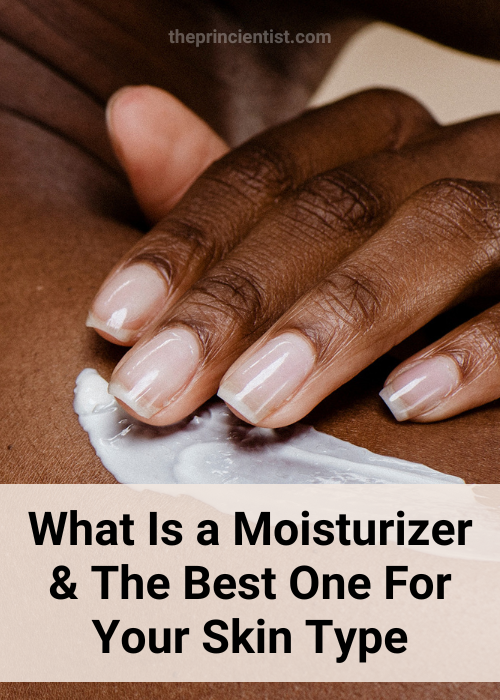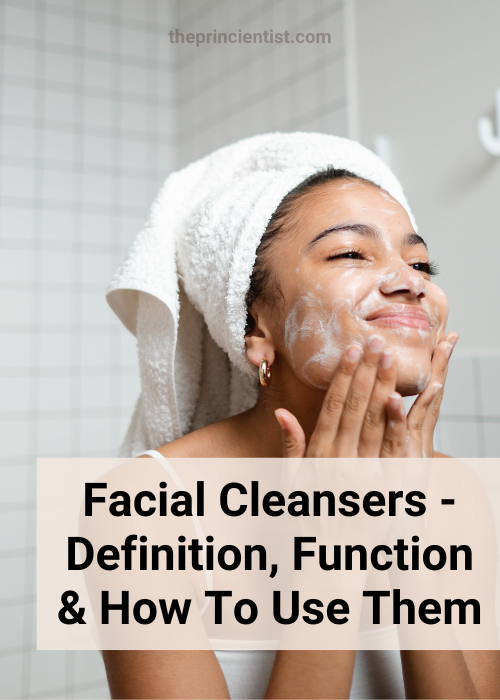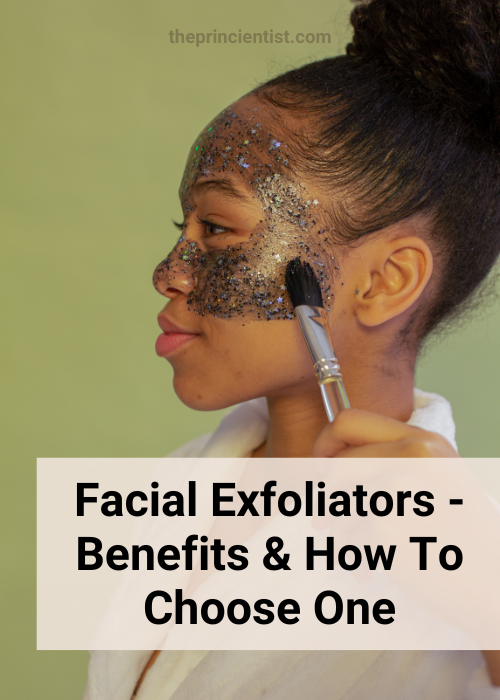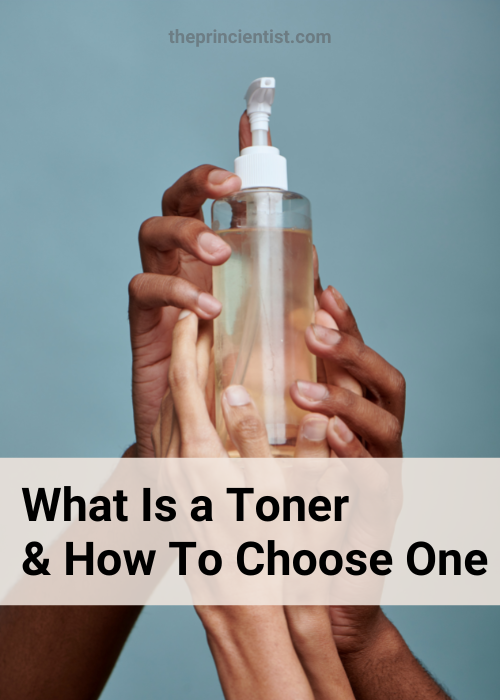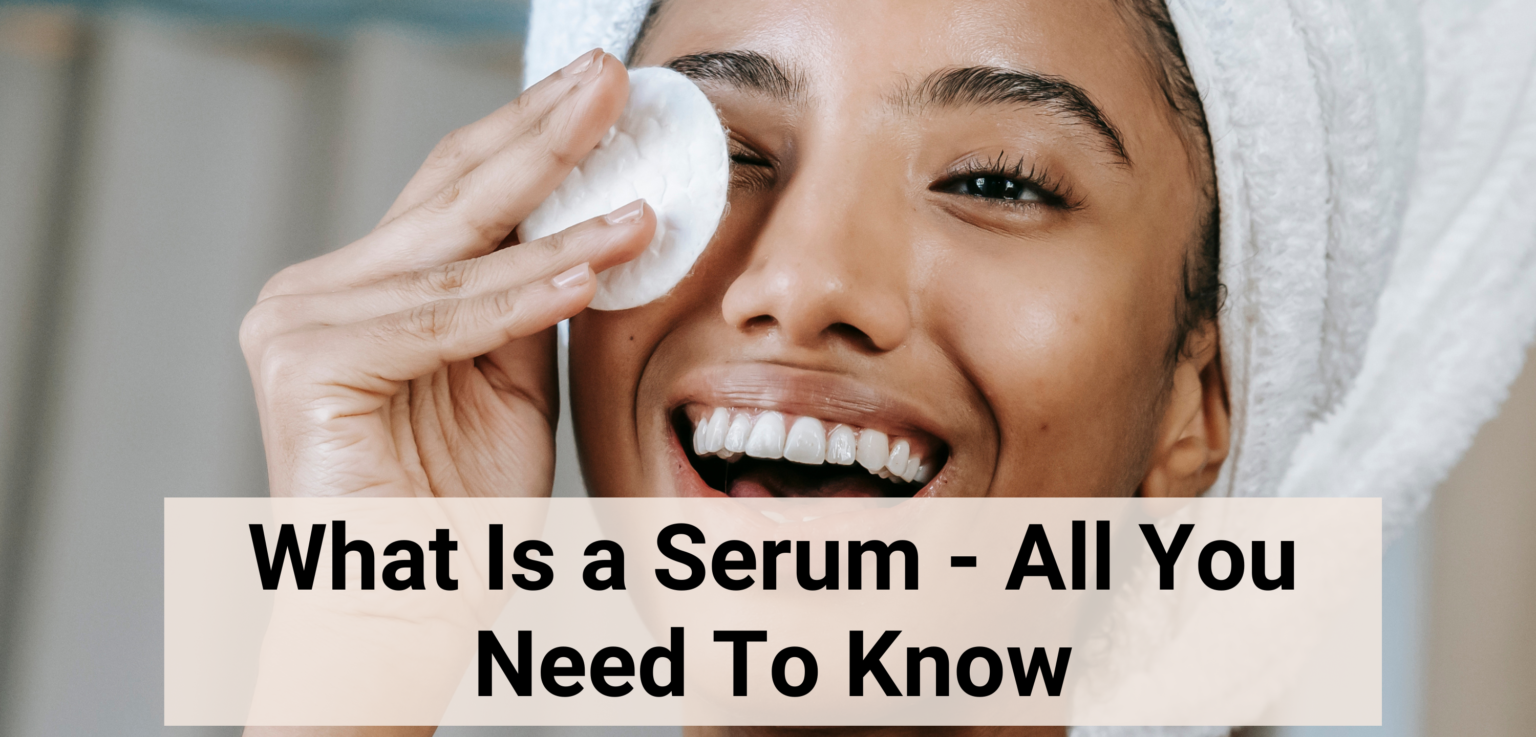
Serums Made Easy
You will learn what is a serum, what types of serums exist and how to use them to keep your skin healthy.
This post is a complete guide to serums.
Table of Contents:
- What is a serum?
- What is the function of a serum?
- Serums and essences – what is the difference?
- Serums, Moisturizers, Face creams, facial oils – what is the difference?
- What types of serums exist?
- How to apply a serum. Step-by-step Instructions
- What to do after using a serum?
You can find all references used to write this post here.
What is a serum?
A serum is a liquid skincare treatment product that contains a high concentration of active ingredients and nutrients.
They are optional products in skincare but offer many benefits.
What is the function of a serum?
Serums deliver powerful active ingredients into the skin to treat specific skin problems.
They are designed to effectively penetrate the skin to provide the skin surface and deep layers with a high and concentrated amount of ingredients.
Serum’s ingredients are customizable and can be formulated to target concerns like wrinkles, discolouration, uneven texture, aging, dehydration, dullness and enlarged pores.
A serum is beneficial because its only function is to treat a very specific concern improving your skin faster than other products with multiple roles.
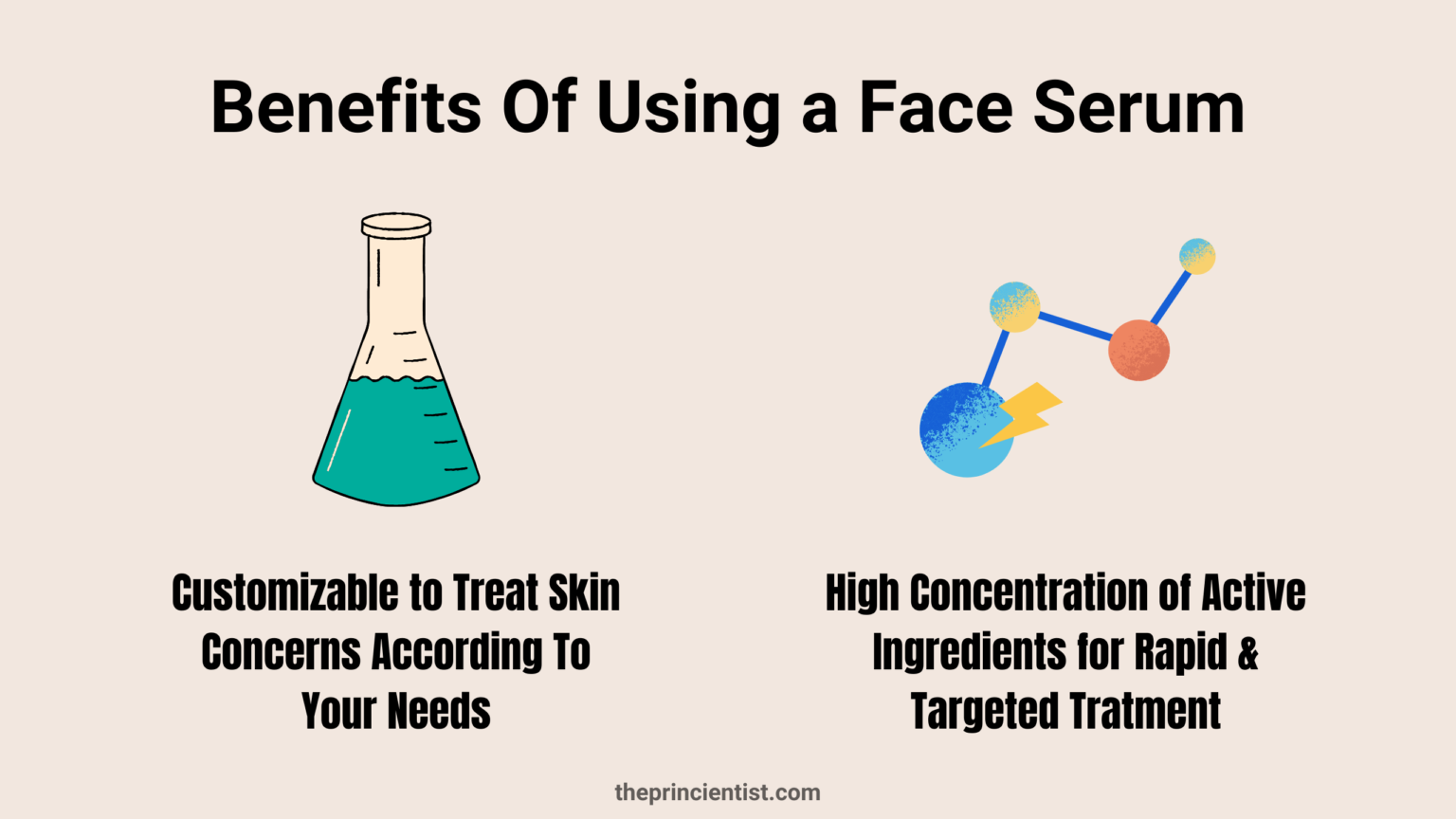
Serums and essences – what is the difference?
You might have heard of essences from the famous 10-step Korean skincare routine.
The terms essences and serums are used interchangeably in Europe and the US, but the two have differences and similarities you can read below.
Texture: serums are thicker and more viscous than essences, that have a water-like consistency.
Application: essences are usually applied after cleansing and toner, just like serums.
Function: both serums and essences target specific skin concerns and deliver active ingredients into the skin to treat them.
But essences are formulated to mainly provide hydration to the skin with a high concentration of humectants.
While serums treat a variety of skin concerns from hyperpigmentation to ageing.
Serums use a variety of active ingredients from acids to antioxidants for this treatment.
Can you use both? Yes. If you want to, use the essence first and then the serum.
The essence provides an extra layer of hydration that makes sure the serum can penetrate deeper into the skin.
But it is not a necessity. Just one of them is enough.
If you are not sure which product is the best choice for you, consult a dermatologist or an esthetician.
Related: Are Essences and Toners The Same? (Coming Soon)
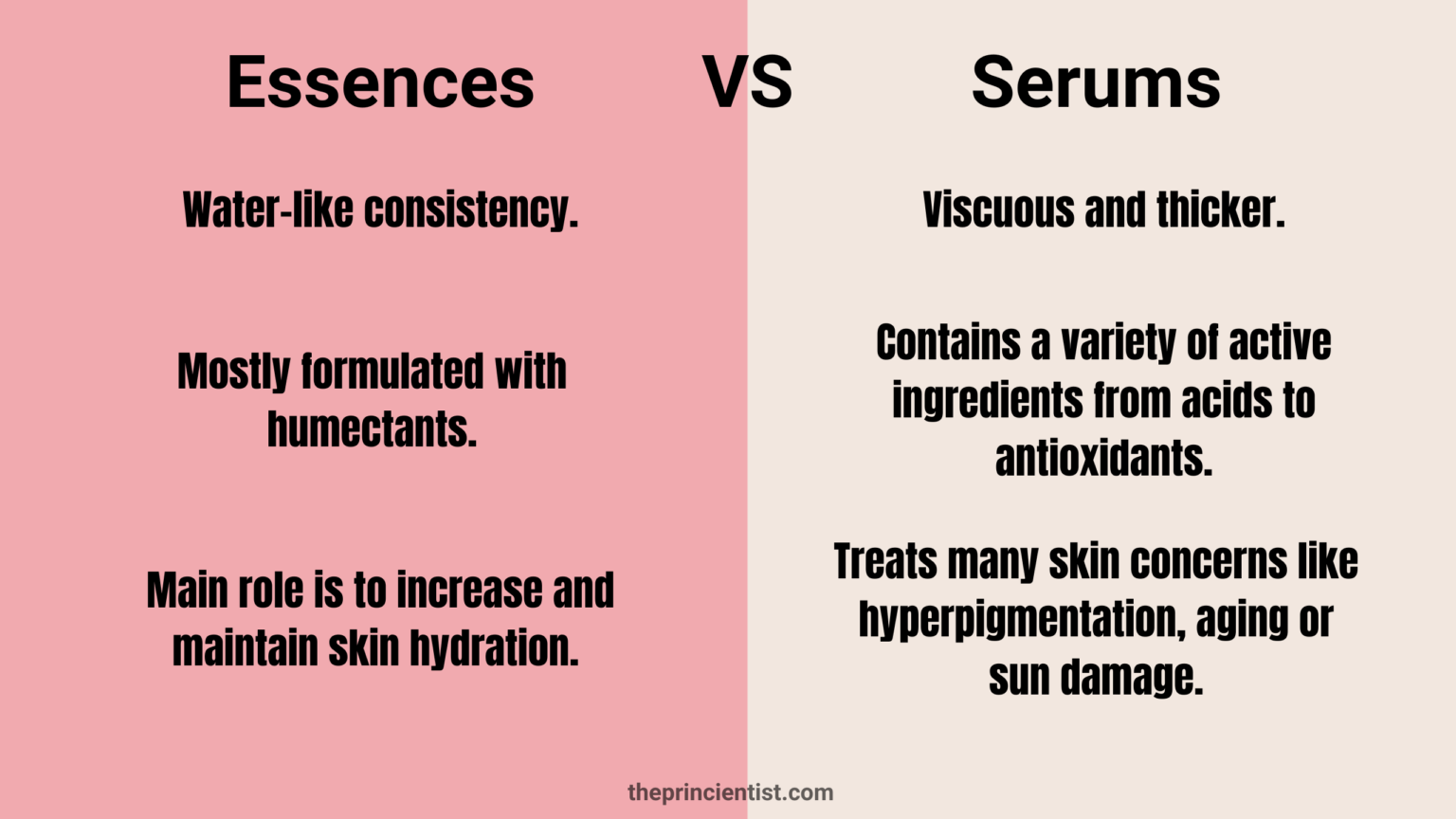
Serums, moisturizers, face creams, facial oils – what is the difference?
A serum consists of small molecules that are designed to absorb completely into the skin. It penetrates the skin and acts in the deep layers.
Moisturizers, face creams and facial oils create a barrier on the skin’s surface not allowing water and active ingredients to evaporate. They affect only the surface layer of the skin.
They function as a protective barrier over the skin that would stop the absorption of any further products.
For this reason, you should always apply a serum before a moisturizer, cream, or oil to allow the active ingredients to deeply penetrate and nourish the skin.
The moisturizer will work to lock those ingredients in the skin.
What types of serums exist?
There are 2 types of serums: water-based and oil-based serums.
Water-based serums
Water-based serums have water as their main component and penetrate faster into the skin.
They are formulated with active ingredients that dissolve well in water like Vitamin C and hyaluronic acid.
Oil-based serums
Oil-based serums have different oils as their main component and don’t contain any water-based ingredients.
They are formulated with several oils and active ingredients that dissolve well in oil.
They work on the skin’s top layers improving skin texture and appearance.
Depending on your skin type and skin concerns you may not wish to add products that contain oil into your skincare routine so it is important to check.
You can tell which type of product it is by looking at the ingredient label.
If water, aloe vera or tea are listed as an ingredient in your product, it is a water-based product.
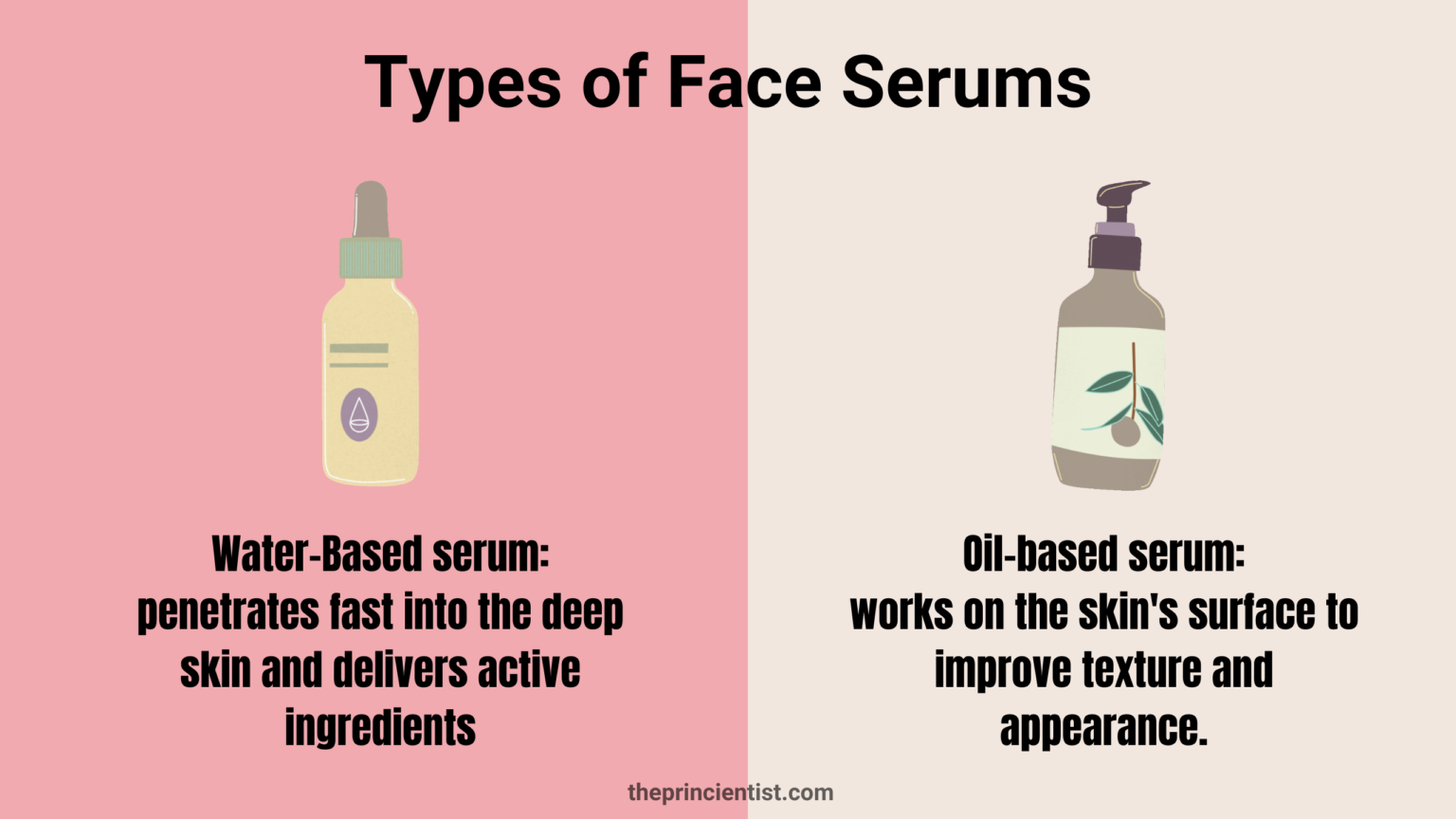
Within the oil and water-based types, you can categorize serums based on what they do as antioxidant, anti-acne, hydrating, brightening, or anti-aging.
Hydrating Serum
What it does: Increases and maintains the hydration levels (water) in your skin.
Benefits/result: you’ll get a youthful look and feel. Skin plumpness and firmness.
Application: should be applied to damp skin (damp with toner or water). Always use a moisturizer after to avoid losing water.
It is a big mistake not to use a moisturizer after a hydrating serum.
The humectants present in the serum will attract water from the deep layers of the skin.
If you don’t have enough moisture (oil) to lock in the water in the skin it will evaporate leaving your skin more dehydrated than before.
Ingredients: look for humectants like Polyglutamic acid, hyaluronic acid, glycerin, aloe vera, betaine and panthenol.
Skin type: All skin types that are experiencing dehydration could benefit from a hydrating serum.
But dry skin that loses water naturally should consider adding it to their skincare routine.
Oily skin types can also benefit from hydrating serums that hydrate the skin without adding more oil.
Related: What Are Humectants? (Coming Soon)
Brightening Serums
What it does: brightens skin and evens out skin tone and reduces visible signs of pigmentation and discoloration.
Skin brightening ≠ skin whitening. Brightening is to treat dull skin and not make skin whiter.
These products only lighten non-normal pigmentation and leave your skin with an even skin tone.
Benefits/Result: You will see a more radiant appearance, skin glow and faded dark spots.
Application: apply directly to dark spots, sun damage, blemishes, or other localized discolorations on the skin.
Ingredients: look for ascorbic acid (vitamin C), vitamin B3, niacinamide and kojic acid. AVOID hydroquinone (used for skin bleaching) and parabens.
Skin type: Oily and combination skin types can benefit because they tend to accumulate dead skin cells on the skin surface that leaves the skin dull.
Antioxidant Serums
What it does: protects the skin against free radicals (unstable molecules that react with your skin) that damage the skin, and prevents premature aging.
They also brighten the skin, are anti-inflammatory and reduce UV damage when used with SPF.
Benefits/Results: glowing, calm, youthful skin. It helps in healing scars and fighting hyperpigmentation.
Ingredients: look for vitamin A, vitamin C, vitamin E, resveratrol, melatonin, certain peptides, enzyme Co-Q10, and alpha-lipoic acid.
Skin type: All skin types can suffer damage and can use this type of serum for treatment or damage prevention.
Anti-acne Serums
What it does: prevents skin breakouts, removes dead skin cells and clears out excess sebum, dirt, makeup and impurities from the skin surface.
Benefits/Results: improve your skin’s texture for a clear, smooth complexion.
Ingredients: look for chemical exfoliators like AHA’s – glycolic and mandelic acids and BHAs – salicylic acid.
Skin Type: Oily and combination skin types that are prone to acne.
Related: More About Chemical Exfoliators
Anti-aging Serums
What it does: reduces the appearance of fine lines and wrinkles. Stimulates skin cell turnover and collagen production.
Benefits/Results: tight and firm skin.
Ingredients: Retinol, caffeine, green tea, proteoglycans and hyaluronic acid, niaciamide, and antioxidants.
Skin Type: Anti-aging serums are beneficial for all skin types.
Related: Skin Cell Turnover & Why it Matters For Beautiful Skin. (Coming Soon)
How often should you use a serum?
On average, you need seven weeks to see the benefits of a new serum.
As for its frequency of use, always read the label for that information.
The label will also inform you about which time of the day is best for application.
In general, you can use most serums twice a day. Once in the morning on a cleansed face, and once at night before bed.
Or you can choose to use a serum only once a day. In that case, it should be used at night before bed.
Most experts agree that serums are particularly effective when applied at night.
It is during this time that the skin naturally regenerates and can make the most out of the active ingredients in the serum.
Usage exceptions: retinol and serums that contain exfoliating acids (AHAs, BHAs, PHAs) should be used at night because they make the skin sensitive to sunlight.
If you use them during the day application of an SPF is mandatory.
Are serums for everyone?
No. Serums are treatment products.
Teenagers and people under 25 don’t need to add serums to their skincare routine unless it is recommended by a dermatologist.
If you are over 25 but don’t have a skin condition that requires treatment you don’t need a serum.
Using a serum when you don’t need one or using the wrong serum can cause a variety of skin problems like redness, breakouts, dry patches, uneven texture, and inflammation.
If you choose to use a serum, a hydrating or antioxidant serum is more appropriate to begin.
But I advise you to consult with a board-certified dermatologist who can find the best serum for your routine.
General Cautions:
– Before using any serum, test it on a small area of skin first. If you don’t experience a reaction within 24 hours, the serum is safe to use on the rest of your face.
– Start using a new serum once a week for a month and if you see no negative reaction (rash, redness, inflammation) you can gradually increase its frequency in use.
– Always use caution when combining acid-containing serums with other skincare products that also contain acids like toners and exfoliators. They can be incompatible and cause reactions.
– Do your research on the compatibility of the active ingredients in your skincare products (toners, serums, cleansers) before using.
– Using a toner before applying a serum increases the serum’s absorption into the skin making it more effective.
– Retinols and exfoliating serums cause sun sensitivity and should be applied at night when there is no exposure to sunlight.
– Do not mix your serum with other products. Always apply it separately so they can access your skin without obstructions and deliver the ingredients more effectively.
– Serums are not meant to be layered. If you are using more than one serum, apply one in the morning and the other in the evening, on clean skin.
– Only one of the products of your skincare routine should be an exfoliator or retinol to avoid skin irritation and increased dryness. Verify if other products you are using are also exfoliators.
– Use serums separately first before you layer to understand how your skin reacts to each serum individually.
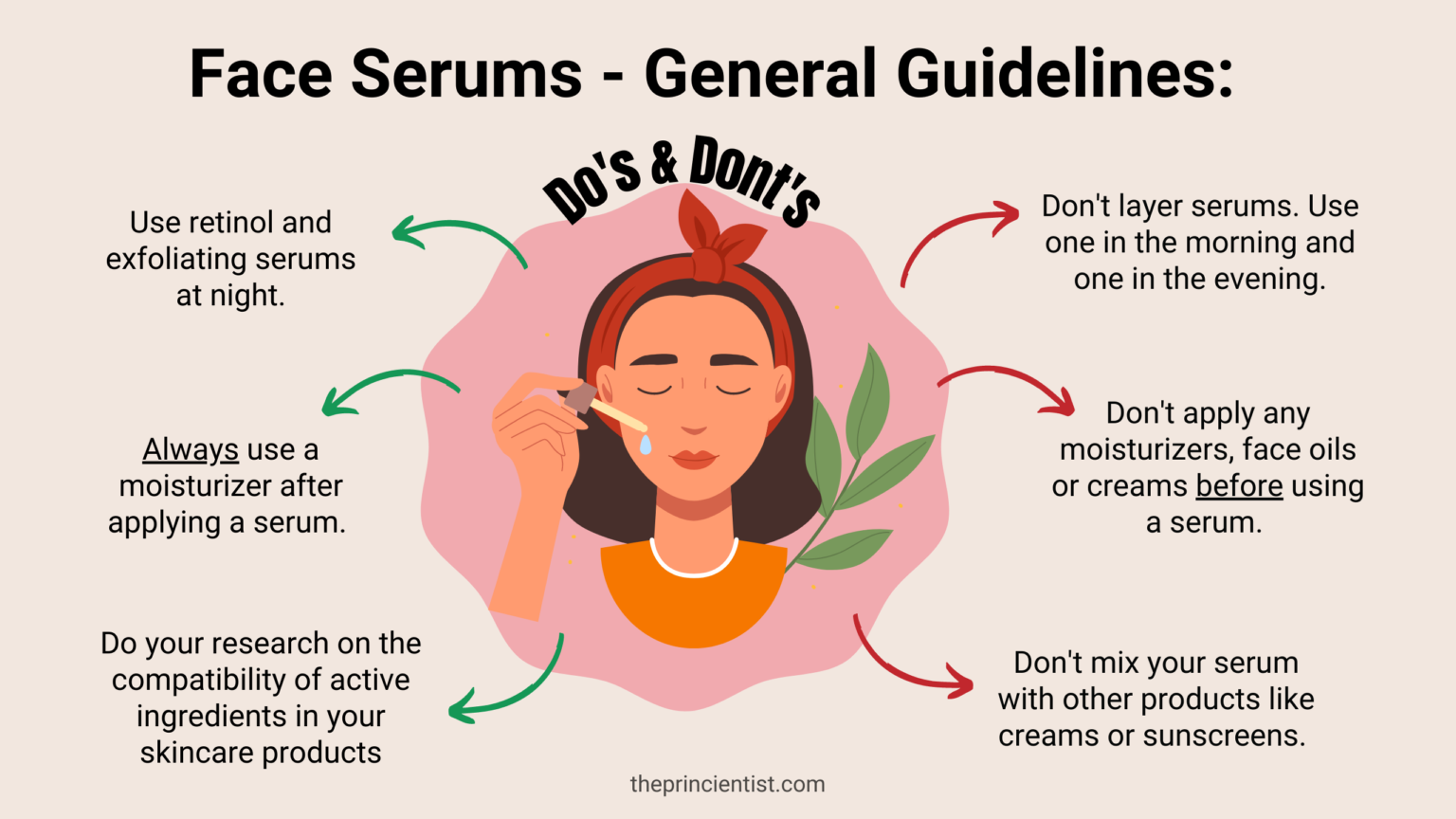
How to choose a serum?
Choose a serum by considering 4 factors: seasons, the concentration of active ingredients, skin condition and skin type.
Seasons:
Your skin changes with the seasons.
You may need a hydrating formula during winter because your skin feels dry and a more protective formula during summer to protect from damage.
Re-evaluate your skin needs at the beginning of each season and choose your serums accordingly.
Concentration of Active Ingredients:
Cosmetic labels have their ingredients ordered by the descendant amount existing in the product.
The lower the active ingredient is on the package the less active your serum will be. You want your serums to be highly concentrated in active ingredients.
The best practice is to read labels to find the best formulation for your needs and understand which percentages work best on your skin type and skin tone.
Related: Serum Ingredients & What They Do. (Coming Soon)
Skin condition:
Figure out your skin’s specific needs and the desired effect you wish to achieve.
Make a list of your skin concerns and choose your serums based on the ingredients that deliver the change you need.
To avoid using multiple serums choose multi-tasking ingredients that do more than one thing.
I leave you a table below that can help you decide.
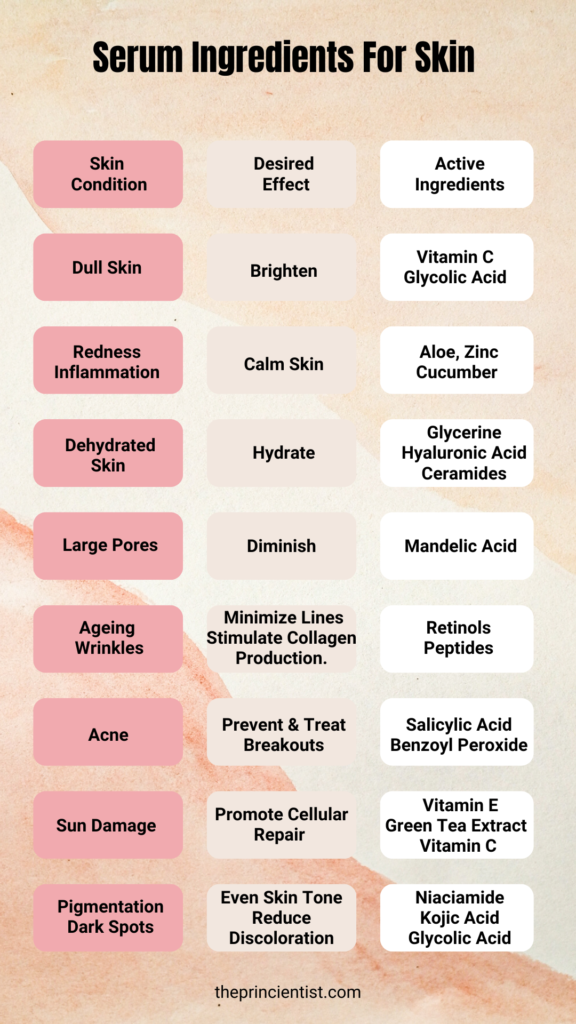
Note: Due to its rapid skin absorption glycolic acid can be heavy on melanated skin. Mandelic acid has the same effects and prevents possible pigmentation issues and burns on dark skin.
Skin type:
Take into consideration your skin type.
Different skin types are prone to different skin conditions and have different needs.
Oily skin
This skin type produces excess sebum.
Common skin concerns: acne, inflammation, dehydration.
Serum Categories: choose according to your skin’s needs
– Water-based hydrating serums that hydrate without adding more oil to the skin. Look for hyaluronic acid or niacinamide.
– Antioxidant serums soothe and smooth the skin if you are worried about redness and inflammation. Look for vitamin C and retinol.
– The excess oil makes oily skin prone to acne. Anti-acne serums that contain gentle acids can be helpful. Antioxidant serums have shown to be beneficial for acne as well. Look for salicylic acid.
– Oil-based serum balances the skin by signalling that the skin surface has enough oil and stops its excess production.
Some oils also have anti-inflammatory properties that can help reduce breakouts
Dry skin
This skin type produces small amounts of sebum (skin’s natural oil), causing the evaporation of water from the skin leaving it dry.
Common skin concerns: dehydration, sensitivity
Serum Categories: choose according to your skin’s needs
– Choose a hydrating serum to maintain water levels in the skin. Always apply a moisturizer or facial oil after. Look for niacinamide and hyaluronic acid.
Hyaluronic acid can hold 100 times its weight in water effectively hydrating the skin and niacinamide increases ceramide levels in the skin.
– Oil-based serums are beneficial because this skin type lacks oils. Many oils possess anti-inflammatory properties that quickly calm sensitivity in dry skin.
Look for olive oil and jojoba oil that provides intensive moisture.
Normal skin
This skin type is well-balanced and does not produce little or excess oil.
Common skin concerns and serum categories: normal skin may become dehydrated over time and need a hydrating serum or damaged and need an antioxidant serum.
Instead of a brightening or anti-acne serum, exfoliating frequently is better to keep this skin type bright and smooth.
If you don’t have any skin concerns, you don’t need a serum.
Combination skin
This skin type has both dry and oily areas in the skin.
Common skin concerns: both oily skin concerns and dry skin concerns
Combination skin may need a combination of serums to balance oiliness and dryness on the skin.
Instead of layering serums alternate between them by using one in the morning and one in the evening.
Consult a dermatologist for the best choice in your case.
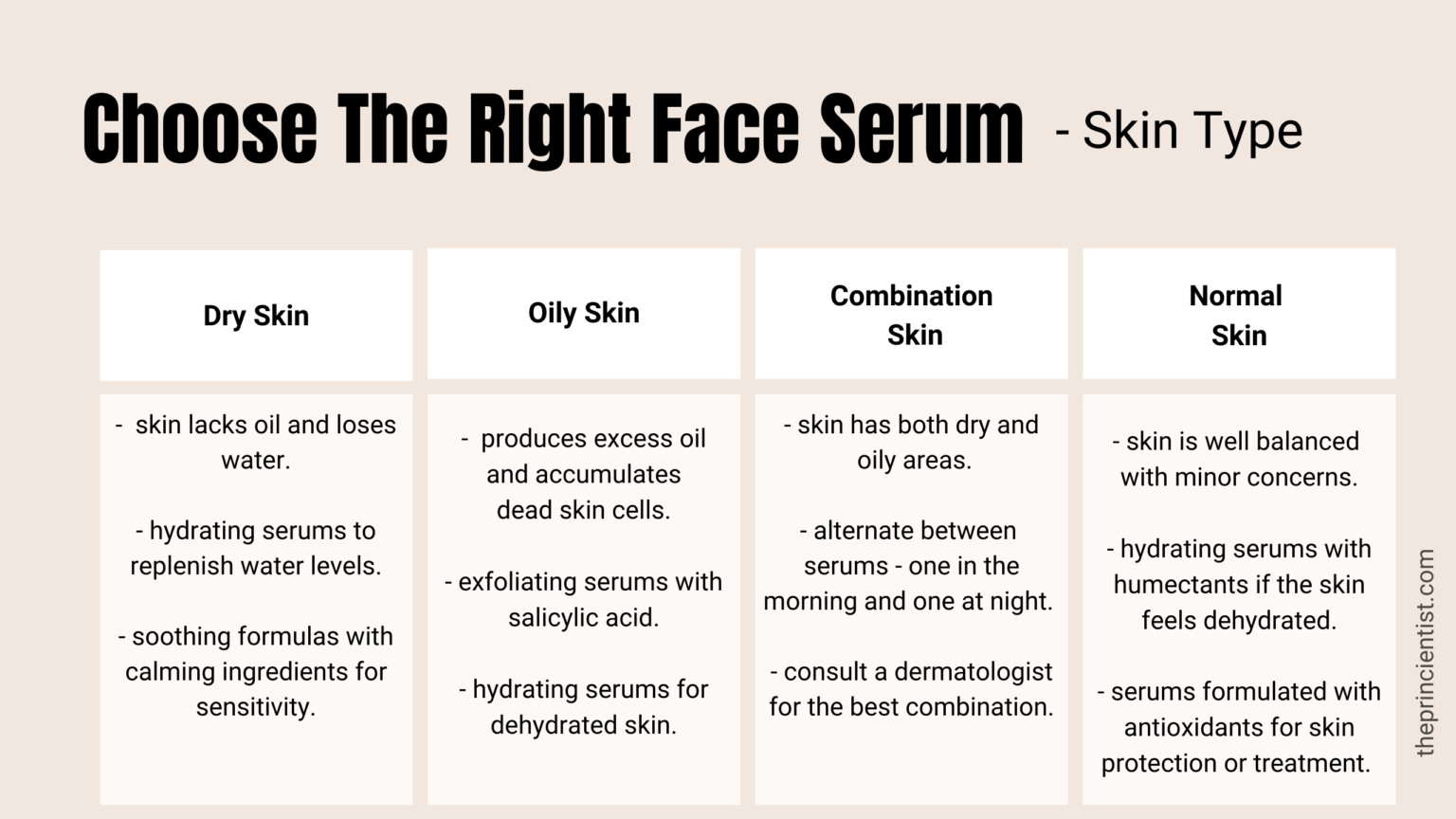
How to apply a serum? Step-by-step
- Cleanse your skin properly. Dirt and dead skin cells can impede the serum from absorbing.
- Apply a toner evenly all over your face. Leave the skin damp on toner for the application of the serum.
- Apply 3-4 drops of serum to your fingertips and pat on the damp skin. Avoid touching the dropper bottle to your face.
- Avoid rubbing your hands too much so that the serum won’t be absorbed in your hand’s skin and be wasted.
- Let the serum dry
- Apply the next product of your routine.
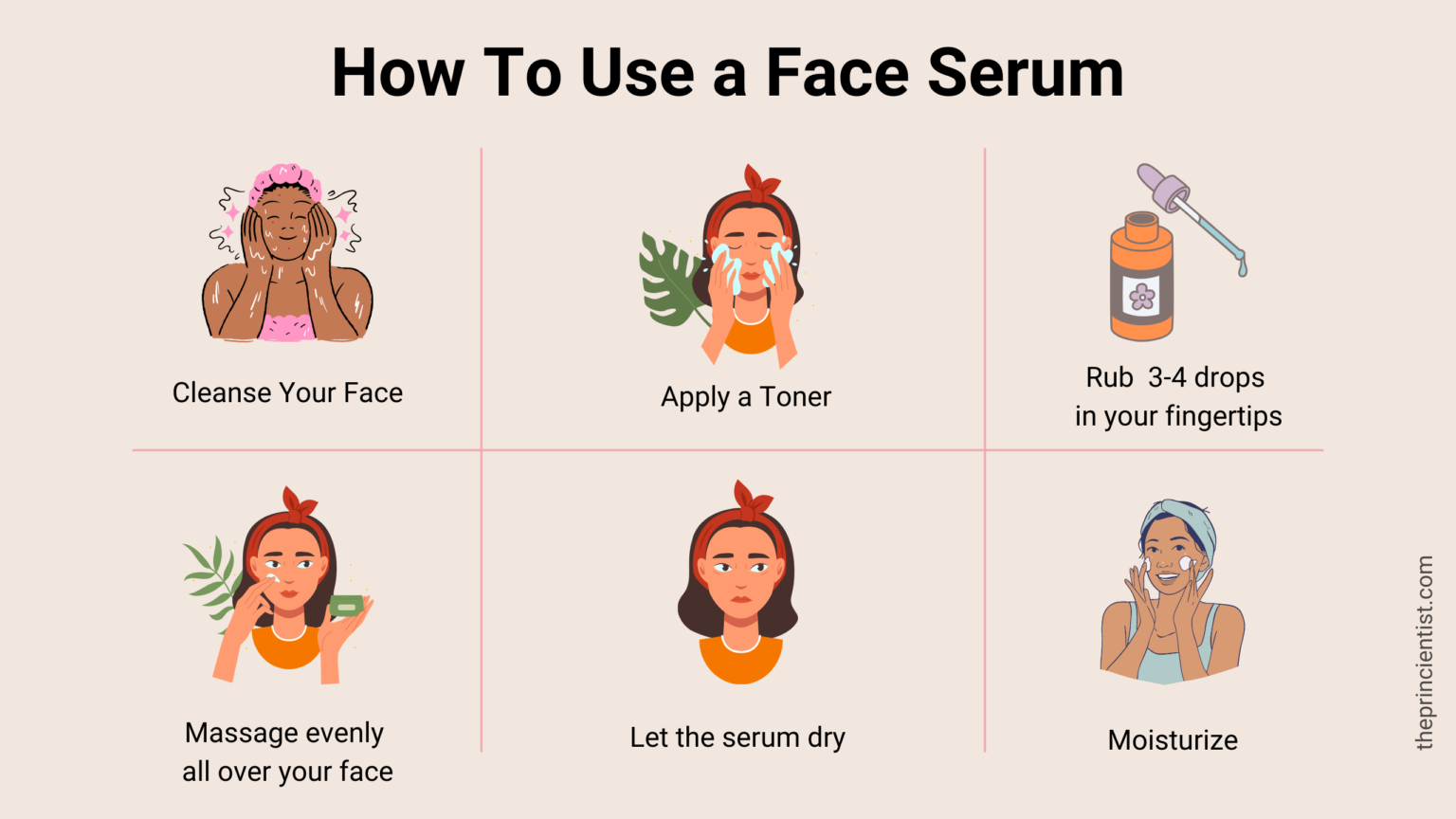
Note: Your skincare routine should cover your face, neck, ears, chest and hairline.
What to do after using a serum?
Once your final layer of serum has penetrated the skin and dried, you have to seal it in so that any humectants and other active ingredients don’t evaporate or degrade.
Apply a moisturizer, a face cream or a face oil.
They protect the skin create a protective layer on the skin to protect it from daily insults of the environment and assist in preventing premature skin aging.
Different skin types need different moisturizers. I have the perfect post to help you make the best choice.
Read below the complete guide on moisturizers.
What is a moisturizer and how to choose the best moisturizer for your skin type.
Read the complete guide to moisturizers.
Disclaimer: This article is informational only. This article does not provide medical advice, diagnosis, or treatment. Any information published on this website or by this brand is not intended as a substitute for medical advice, and you should not take any action before consulting with a healthcare professional. If you have questions or concerns about caring for your skin, you should make an appointment to see a board-certified dermatologist.
You Might Be Interested In
Skincare Products Made Easy – Article Series
What is an exfoliator. Differences between Chemical and physical exfoliators. How to choose an exfoliator for each skin type.
What toner do and why you need one. How to choose the right toner for your skin type.
